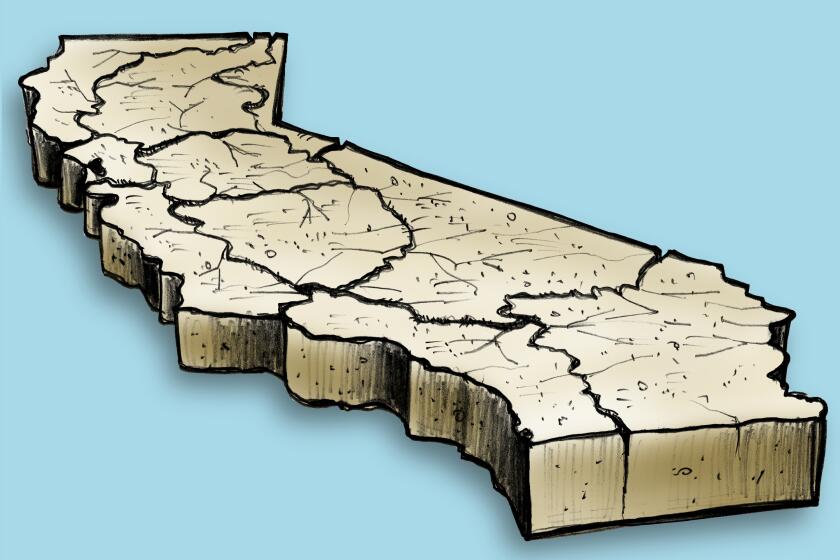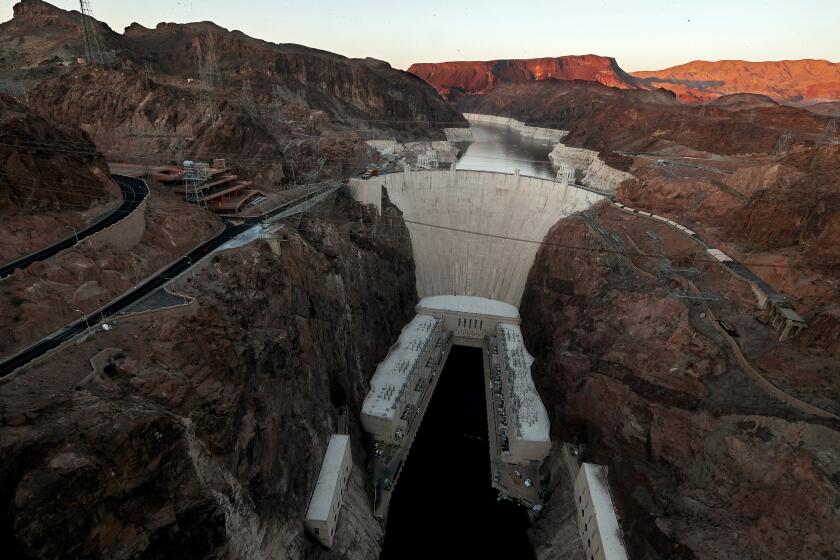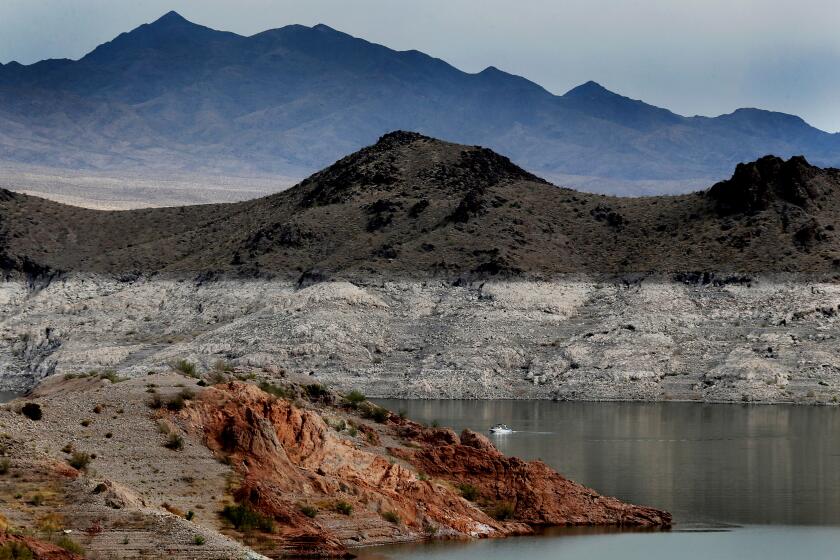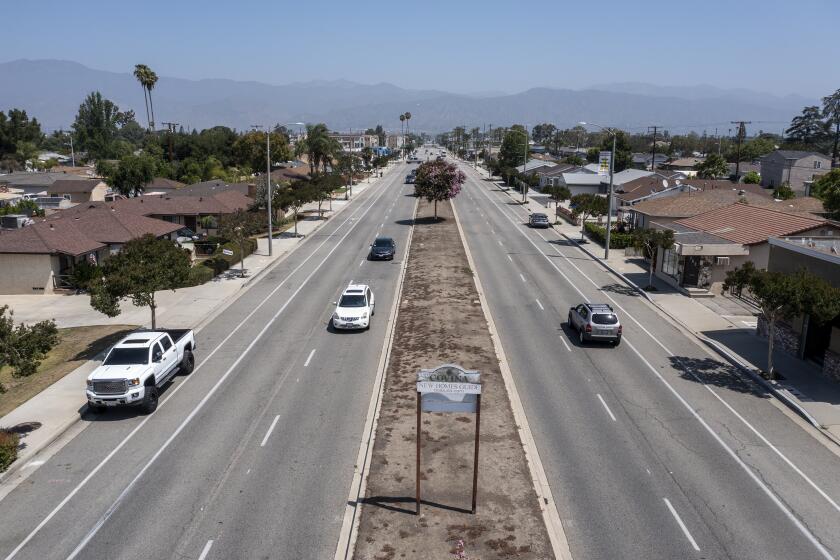California is finally reducing water use, but it’s not enough amid severe drought

- Share via
With reservoirs at record lows and Lake Mead inching closer to “dead pool” levels, Californians are beginning to heed the state’s urgent calls for water conservation — but not fast enough, officials said Friday.
After months of middling efforts — including a 17.6% increase in urban water use in April — residents in May saved 3.1% more water than in the same month in 2020, the baseline year against which current data are measured, according to new figures from the State Water Resources Control Board.
Preliminary numbers for June trend toward an even greater statewide savings of 7.7%, but experts cautioned that more is needed as California enters the hottest, driest part of the year and descends even deeper into a third year of drought.
“It’s progress in the right direction, but it’s still disappointingly slow,” said Peter Gleick, co-founder and senior fellow of the Pacific Institute. “Maybe the message is starting to get out, but much more needs to be done to help people understand the severity of the drought and what they can do to cut their water use.”
The latest maps and charts on the California drought, including water usage, conservation and reservoir levels.
Indeed, many experts had been looking toward May as a potential bellwether of residents’ willingness to change after the abysmal start to the year. The Metropolitan Water District of Southern California — the region’s massive water wholesaler — issued a call for an unprecedented reduction in water use at the end of April.
Dozens of water agencies, including the Los Angeles Department of Water and Power, reduced residents to either one- or two-day-a-week outdoor watering on June 1 in response to the MWD’s order.
The latest figures indicate the message is seeping in, albeit only slightly, with the South Coast hydrologic region that is home to Los Angeles eking out a 2.2% savings in May. The number was an improvement over April, when the region used about 26% more water compared with the same month in 2020.
In fact, nearly every part of the state posted some savings, with the North Lahontan hydrologic region that spans the northeastern edge of the state posting the most at 18.6%. Only one area, the Colorado River hydrologic region in southeastern California, saw an increase in water use at 8.9%.
But while the data “reverses the trend we saw in March and April,” the state’s cumulative numbers leave much room for improvement, water board officials said. Statewide savings since last July, when Gov. Gavin Newsom called on residents to voluntarily cut water use by 15%, were only 2%.
“So far, weather and precipitation have been determining California’s water use instead of our collective drive to conserve,” a board report about the May numbers read. “Many Californians turned on irrigation systems earlier this year in response to historically hot and dry conditions, increasing water use. We must continue to make up lost ground from past months to meet the 15% goal; doing so will require more aggressive conservation actions on everyone’s part.”
About 97% of the state is now under severe, extreme or exceptional drought conditions, the three worst categories under the U.S. Drought Monitor.
In response to the worsening conditions, Newsom last month warned that stricter statewide actions were on the table if efforts didn’t improve.
On June 10, the water board required all urban water suppliers to implement Level 2 of their emergency drought restrictions. It also took the step of banning the irrigation of “nonfunctional grass,” or grass that is purely decorative, at businesses and in common areas of subdivisions and property controlled by homeowner associations.
Newsom’s office on Friday said the recent gains were “a positive trend in response to the governor’s latest actions and local measures” but reiterated that the results were far below the desired 15%.
“Individuals and California businesses need to step up,” said Erin Mellon, a spokesperson for the governor.
On Friday, Lake Shasta, the state’s largest reservoir, sat at 39% of its capacity, about half its average for this time of year.
As the Colorado River water shortage worsens, major cutbacks are needed to reduce most perilous risks, a federal official tells senators.
What’s more, Lake Mead, the nation’s largest reservoir, was about 27% full. Federal officials have warned that the reservoir along the Colorado River is only 150 feet from dipping below its lowest intake valve, known as “dead pool,” which could potentially cripple water supplies in the western United States.
Gleick, of the Pacific Institute, said he hoped officials would do more to “emphasize the seriousness of the challenge.”
“We’re going to see reservoirs continue to fall; we’re going to see more and more wells drying up in the Central Valley as groundwater continues to be overpumped; we’re going to see deaths of salmon in the Sacramento River,” he said. “The things that we see every time there’s a drought in California, we’re going to continue to see as long as we’re not able to change the way we manage and use water.”
Recurring drought and rising temperatures have already begun to alter the landscape of California and the American Southwest, researchers warn.
But there are some signs of progress. Officials with the Los Angeles Department of Water and Power said Angelenos filed 1,198 reports of water waste in May — significantly more than in the same month last year, when 544 such reports were made.
“We are very encouraged by the increase in water waste complaints we have received — it shows people are taking the drought seriously and trying to cut back their use as well as reporting on potential violations of the ordinance,” DWP spokeswoman Ellen Cheng told The Times last month.
Some of the common complaints are water running off lawns and into the street because of excessive irrigation or people watering on the wrong days, she said. Under new city rules, residents with even-numbered addresses can water on Sundays and Thursdays, and odd-numbered addresses can water Mondays and Fridays.
Brad Coffey, group manager at the Metropolitan Water District, said demand from MWD’s member agencies was about 4% below the volumetric target during the first month of restrictions, a sign of improvement.
“We think we’re beginning to see the ship turn and more conservation being implemented, so that’s a very positive thing for us,” he said. But he also noted that month-to-month comparisons are dependent on specific conditions, such as heat and rainfall, and aren’t necessarily the greatest indication of change.
“We need to do more, that’s a fact of the matter, and we know we can do more,” he said. “We encourage our consumers to really look at their water-use practices, particularly outdoors, and trim back as much as they can.”
More than 6 million Southern Californians will be placed under new drought rules today in an unprecedented effort to conserve water.
On Thursday, state and local leaders gathered in Pasadena to highlight drought response items in the recently signed 2022-23 state budget.
The budget allocates $2.8 billion for drought response and water resilience, officials said, including $175 million for water-saving strategies such as turf replacement.
“One of the best ways we can become more water efficient is by replacing thirsty grass with California-friendly and native plants that use up to 85% less water,” said Cynthia Kurtz, vice chair of the MWD board of directors. “If you have a lawn that no one uses, that is only walked on when it is mowed, now is the time to replace it with a beautiful, sustainable, water-efficient landscape.”
But while irrigation, infrastructure and adaptation all help, officials also emphasized the need for everyone to get on board with conservation.
“As drought intensifies across the West, we all need to do our part to save water and stretch our water supplies,” said Wade Crowfoot, secretary of the California Natural Resources Agency.
Whether those calls will work in the long run remains to be seen. The water board said the final urban water data for June — the first full month of water cuts in much of Southern California — will be released at the start of August.
More to Read
Sign up for Essential California
The most important California stories and recommendations in your inbox every morning.
You may occasionally receive promotional content from the Los Angeles Times.















